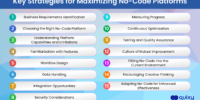Quality Assurance (QA) is the backbone of successful software development. Rigorous software testing ensures that applications meet high standards of functionality, reliability, and performance. In this guide, we’ll explore quick tips to elevate your QA quotient, helping you implement effective testing strategies and deliver top-notch software products.
1. Understand the Requirements Thoroughly
Start your QA process by thoroughly understanding the project requirements. A clear understanding of the expected behavior and functionalities is essential for designing relevant test cases. This foundational step ensures that your testing efforts align with project goals.
2. Create Comprehensive Test Cases
Design comprehensive test cases that cover various scenarios, including positive and negative test cases. Clearly document the expected outcomes for each test case. Well-structured and exhaustive test cases serve as a roadmap for your testing process and help in identifying defects early.
3. Implement Test Automation Where Feasible
Consider test automation for repetitive and time-consuming test scenarios. Automated tests can significantly speed up the testing process, enhance test coverage, and improve overall efficiency. However, exercise caution and balance automation efforts with manual testing for nuanced scenarios.
4. Prioritize Test Cases for Regression Testing
Regression testing is crucial to ensure that new code changes do not adversely affect existing functionalities. Prioritize test cases based on critical features and functionalities to perform effective regression testing. This helps maintain the integrity of the software after each update.
5. Perform Exploratory Testing
Supplement scripted testing with exploratory testing to uncover unforeseen issues. Exploratory testing allows testers to navigate the application freely, leveraging their intuition and experience to identify potential defects that might be missed through scripted scenarios alone.
6. Conduct Performance Testing
Include performance testing to evaluate how the system behaves under different workloads. Performance testing encompasses load testing, stress testing, and scalability testing. Identifying and addressing performance bottlenecks early in the development process is critical for a robust application. ⚙️
7. Collaborate with Developers
Establish effective communication and collaboration with developers. A close working relationship facilitates the understanding of the codebase, promotes knowledge sharing, and enables quicker resolution of identified issues. Collaborative efforts lead to a more cohesive and reliable QA process.
8. Emphasize Security Testing
Security testing is integral to ensure that applications are resilient to potential threats and vulnerabilities. Include security testing measures such as penetration testing and code analysis to identify and address security loopholes. Prioritize data protection and privacy.
9. Utilize Testing Environments Effectively
Create and manage testing environments that closely mimic the production environment. This ensures that tests are conducted in an environment that accurately represents real-world scenarios. Consistent testing environments contribute to reliable and reproducible results.
10. Document Test Results and Defects Thoroughly
Document test results and identified defects comprehensively. Clear and detailed documentation facilitates efficient communication with the development team, enabling them to understand and address issues promptly. Track the resolution of defects and update documentation accordingly.
Conclusion
Elevating your QA quotient involves a combination of strategic planning, effective communication, and a commitment to delivering high-quality software. Understand project requirements thoroughly, create comprehensive test cases, implement test automation judiciously, prioritize regression testing, perform exploratory testing, conduct performance and security testing, collaborate closely with developers, utilize testing environments effectively, and document results and defects meticulously. By incorporating these quick tips, you’ll enhance your QA processes and contribute to the development of robust and reliable software products.








